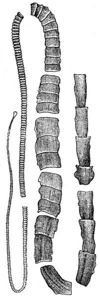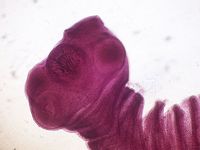Difference between revisions of "Taenia"
| Line 19: | Line 19: | ||
==Introduction== | ==Introduction== | ||
| − | Like most adult tapeworms, Taenia species live in the small intestine. | + | Like most adult tapeworms, Taenia species live in the small intestine. They are [[Cestodes|cestodes]], and the different species vary in length from 0.5-15m long. Identification is based on the hooks on the scolex. Despite their impressive size, the adult tapeworms of little clinical significance. The metacestodes of some species, however, may cause disease or meat inspection losses. The human pork tapeworm, Taenia solium, is a dangerous zoonosis but, fortunately, it does not occur in the UK. |
=Taenia spp of Humans= | =Taenia spp of Humans= | ||
Revision as of 14:18, 29 July 2010
| This article is still under construction. |
| Taenia | |
|---|---|
| Kingdom | Animalia |
| Phylum | Platyhelminthes |
| Class | Cestoda |
| Order | Cyclophyllidea |
| Family | Taeniidae |
| Genus | Taenia |
Introduction
Like most adult tapeworms, Taenia species live in the small intestine. They are cestodes, and the different species vary in length from 0.5-15m long. Identification is based on the hooks on the scolex. Despite their impressive size, the adult tapeworms of little clinical significance. The metacestodes of some species, however, may cause disease or meat inspection losses. The human pork tapeworm, Taenia solium, is a dangerous zoonosis but, fortunately, it does not occur in the UK.
Taenia spp of Humans
T. saginata
| Also known as: | Cysticercus bovis
|
Hosts
Definitive host: Man.
Intermediate host: Cattle.
Identification
The adult is only found in humans, and is normally 5m in length, but may grow up to 3 times the length. The body is white and has a prominent anterior scolex, but no hooks.
The Proglottid has a thich outer shell, containing several hundred thousand eggs.
Life Cycle
Eggs are past by the host, and survive on the pasture. The oncosphere is then ingested by the intermediate host, the cow in this case. These infect the striated muscle, which are visible as cysts. Humans become infected by ingestion of poorly cooked meat.
T. solium
| Also known as: | Cysticercus cellulosae
|
Hosts
Intermediate host: Pig, and also occasionally the dog and man.
Definitive host: Man.
Identification
The adults are 3-5m in length, have a scolex, and several rows of hooks.
Life Cycle
The life-cycle is similar to that of T. saginata, except now the pig is the intermediate host. Gravid segments, containing the parasite eggs are passed in faeces. The oncospheres are then ingested by the intermediate host, in this case the pig, and pass into the blood system, infecting striated muscles. The cysticerci may also develop in the lungs, liver, kidney and the brain. Like T. saginata, humans, which are the definitive host becomes infected via ingestion of poorly cooked meat.
Taenia spp of the Dog
T. ovis
| Also known as: | Cysticercus ovis
|
Hosts
Intermediate host: sheep, and goats.
Definitive host: dogs and foxes.
Identification
T. ovis is a large tapeworm, usually around 1m in length. It has numerous hooks.
Life Cycle
The intermediate host ingests cysticercus, which hatch in the intestine and later infect the skeletal muscle and the heart. The definitive host becomes infected by ingestion of the intermediate host.
The prepatent period for T. ovis is 6-9 months.
T. hydatigena
| Also known as: | Taenia marginata
|
Hosts
Definitive host: Dog, fox, weales, polecat, and stoat.
Intermediate host: Sheep, horse, cattle, pig and deer.
Identification
T. marginata is a large tapeworm around 5m in length. It has a large scolex, with two rows of hooks. The eggs are oval.
Life Cycle
The intermediate host is infected through the ingestion of tapeworm eggs. Sheep are the most frequent intermediate host, but the cysticerci can establish in other animals. The oncosphere hatches out of the egg in the small intestine of the sheep. Oncospheres travel to the hepatic portal system, where they transform to cysticerci. The grow rapidly while migrating through liver parenchyma, then to the peritoneal cavity. The cysticerci in the peritoneal cavity are approximately 8cm long; often found adhering to the omentum. Usually, liver damage heals, forming fibrotic tracts, which leads to condemnation at meat inspection. If a sheep swallows a whole proglottid, it leads to liver damage, and ultimately death (“cysticercosis hepatica”), but this is a rare event affecting a single animal in a flock.
The definitive host is then infected through ingestion of the infected intermediate host.
T. pisiformis
| Also known as: | Cysticercus pisiformis |
Hosts
Definitive host: Dogs and foxes.
Intermediate host: Rabbits and hares.
Identification
T. pisiformis is around 2m in length, and have large scolexes and hooks.
Life Cycle
Infection of the intermediate host is through ingestion of the tapeworm eggs shed by the dogs. The hatch in the small intestine of the intermediate host, they then continue to develop in the liver and the abdominal cavity.
The definitive host is infected by ingestion of the cysticercus. The prepatent period of T. pisinformis is around 7 weeks.
- It is similar to T. hydatigena, except that the cysticerci are pea-sized and are found on the omentum of rabbits.
T. multiceps
| Also known as: | Multiceps multiceps
|
Hosts
Definitive host: Dogs and foxes.
Intermediate host: Cattle, sheep, pig, horses and man.
Identification
T. multiceps are around 5cm in length.
Life Cycle
The intermediate host is infected via ingestion of the parasite eggs. These eggs hatch in the small intestine. The parasite the migrates to the spinal cord and brain via the blood stream. The definitive host becomes infected when it eats the spinal bord, or brain of the intermediate host.
T. serialis
| Also known as: | Coenurus serialis |
Hosts
Definitive host:Dog.
Intermediate host: Rabbit.
Identification
T. serialis is around 0.5m, with two prominent rows of hooks.
Life Cycle
The intermediate host is infected through ingestion of the tapeworm egg, which is shed by the dog, which acts as the definitive host. These develop and form cysts in the intermuscular connective tissues of rabbits, often causing a soft subdermal swelling. . The definitive host then becomes infected through ingestion of the metacestode.
Taenia spp of the Cat
T. taeniaeformis
| Also known as: | Hydatigera taeniaeformis
|
Hosts
Definitive host: Cats, and foxes.
Intermediate host: Mice, rats, rabbits, and squirrels.
Identification
The adult is around 70 cm, and has a large scolex.
Life Cycle
The eggs are past in faeces, which are ingested by the intermediate host. The metacestode matures in the intermediate host, before being ingested by the definitive host.
References
Taylor, M.A, Coop, R.L., Wall,R.L. (2007) Veterinary Parasitology Blackwell Publishing

